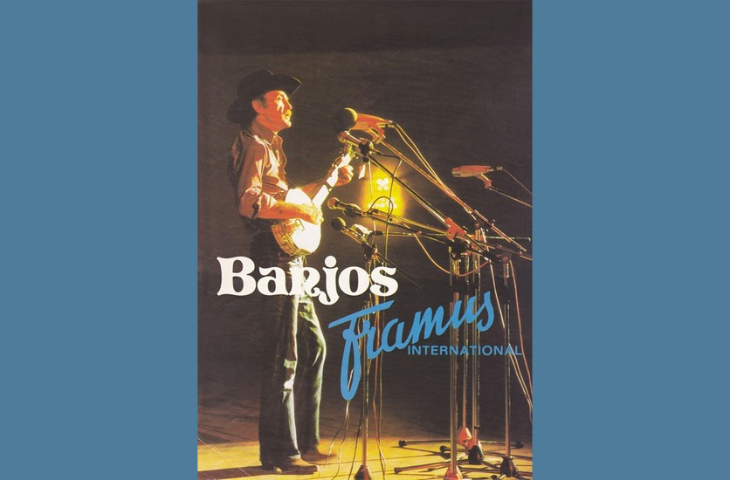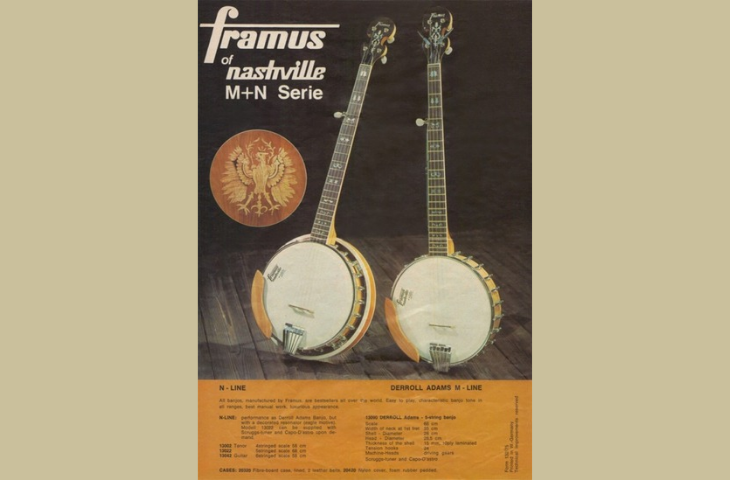November 2025
Fig.1

Derroll Adams / Framus banjo, “Fête des Leus”, Frasnes-lez-Couvin, Belgium, 1978. (Photo Michel Botte), coll. Gérard De Smaele
Fig.2

Five-string banjo, “Derroll Adams” model, Framus, Pretzfeld, Germany, ca. 1974, inv. 2019.0005
Fig.3

Derroll Adams, Framus advertisement, front, 1975. Coll. G. De Smaele, Inv. 2018.299a - Reference 6 R 224a
Fig.4

Derroll Adams, Framus advertisement, back, 1975. Coll. G. De Smaele, Inv. 2018.299a - Reference 6 R 224a
Fig.5

Framus five-string banjo (detail of the peghead), ca. 1974, inv. 2019.0005
5-string banjo « Derroll Adams »
This 5-string banjo was donated to the MIM in 2019. The production of this instrument was supervised by Derroll Adams, to whom the exhibition in the Saintenoy Building is dedicated.
Derroll Adams (fig. 1) was an American singer and banjo player, born in 1925 in Portland, Oregon. He arrived in England in 1957, travelled through France and Italy with Jack Elliott (°1931), whom he had come to join in London, and finally settled permanently in Belgium, where he died in February 2000. From Brussels and then from Antwerp – his strategic hub – the artist made his way across Europe. Armed with a solid musical heritage, enhanced by exceptional talent and charisma, he left his mark on the folk revival of the 1960s and 1970s, both in England and on the European continent. In 2025 we celebrate the centenary of the birth of this legendary figure, born a year after Earl Scruggs (1924–2012) and six years after Pete Seeger (1919–2014), his illustrious contemporary banjoists who revived an instrument that was on the verge of extinction after the war.
The banjo is characterised by its head – a membrane that may be of animal or synthetic origin – and a round-shaped body, while the 4-, 5-, and 6-string instruments are still too often confused by the general public (fig. 2). Despite their similarities, these instruments belong to different musical worlds. With its short string attached laterally to the neck, the configuration of the 5-string banjo takes us straight back to its African origins. Although the tone of the banjos played with a plectrum (such as the tenor and plectrum banjos during the early days of jazz) made a profound impression during the interwar period, it is this original five-string version that historically represents its most enduring form. Today, it is associated with the rich repertoire of traditional American music (in old-time music and bluegrass), whereas in the 19th century the instrument occupied a central place in minstrel shows, later evolving into a style of playing known as “classic” or “fingerstyle.”
Although the minstrel and “classic” styles also enjoyed tremendous popularity in England in the 19th century, it was not until the great folk revival of the 1960s and 1970s that the five-string banjo made a significant reappearance on the European continent. When Derroll Adams arrived in Belgium, it was still conspicuously absent from Brussels music shops. In addition to an unfavourable exchange rate, prohibitive costs made importing from the USA expensive. Those who could not travel to London in search of an antique banjo had to make do with a Framus or a Marma, brands from Germany and Eastern Europe - the only manufacturers of banjos known at that time on our market. Derroll Adams became a key figure and built a solid reputation in folk music circles, mainly in Europe. It was in this context that the artist was approached in 1972 by Fred Wilfer, the director of Framus (made famous by the Zenith 17 acoustic guitar played by Paul McCartney), to distribute in Europe an instrument that was both affordable and of good quality. It remained on sale until the company closed in the late 1970s (figs. 3 and 4).
This 5-string banjo, with a three-star pattern on its peghead (fig. 5), represents the first version of the model. Subsequently, Derroll Adams suggested various adjustments to the design.
Text: Gérard De Smaele
Footnotes
- 1. https://www.derrolladams.org/index.html [official website managed by Jean Leroy until February 2025]
- 2. G De Smaele. Derroll Adams, an ambassador for the United States in Europe.’ Cinq Planètes / Le Canard Folk, June and September 2025: https://www.desmaele5str.be/pdf/derrollAdams.pdf - still to be translated
See also: https://www.desmaele5str.be/pdf/archives/remembering_derroll_adams.pdf - 3. G. De Smaele. Voici le banjo !, La Médiathèque Nouvelle / Cinq Planètes / Le Canard Folk, 2019, 2025, 2025 : https://www.desmaele5str.be/pdf/archives/Voici-le-Banjo.pdf ; https://www.desmaele5str.be/pdf/archives/This-is-the-Banjo.pdf - give preference to the latest version of the Portfolio, with a full transcription of the text shown on the first image: https://archive.org/details/bat-portfolio-web-ep-1/page/n7/mode/2up , see p.5.
- 4. G. De Smaele. The Wayne Adams’ Old ‘Classic’ Banjo: 1897-1952. Frémeaux & Associés, 2022 : https://www.desmaele5str.be/pdf/Old_Classic_Banjo_French.pdf https://www.desmaele5str.be/pdf/Old_Classic_Banjo_English.pdf
- 5. G. De Smaele. Banjo à cinq cordes Projet d’inventaire du don de Mme Saro Hewitt au MiM en juillet 2023. March 2024 : https://archive.org/details/collection-stanley-2_202406 : https://archive.org/details/pete-stanley
Web links
- Descriptions of the banjos in the MIM collection: https://www.desmaele5str.be/pdf/archives/noticesCarmentis.pdf
- A collection of old catalogues held at the MIM: https://www.desmaele5str.be/pdf/archives/CoverCatalogues.pdf
- The American Banjo Museum: https://www.desmaele5str.be/pdf/archives/The-American-Banjo-Museum.pdf
- The collection of James Bollman: https://www.desmaele5str.be/pdf/archives/James-Bollman.pdf